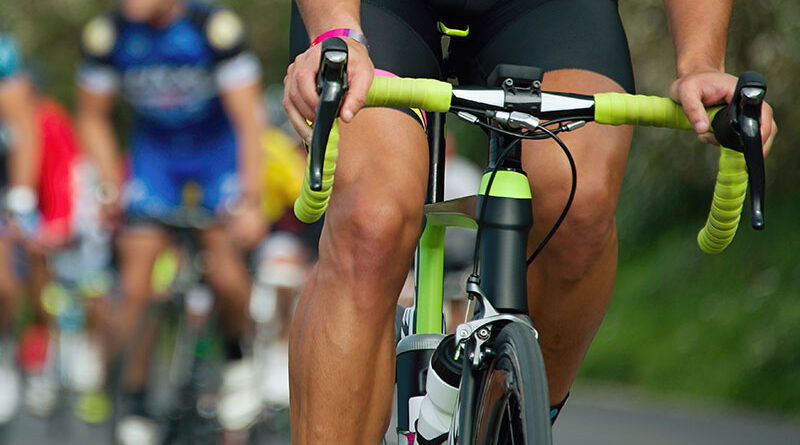Triathletes Aren’t Slowing Down
They say with proper training and diet, you can compete well into your ‘golden years’
By Aaron Gifford
Call them “Tri-guys,” but with four distinct seasons in Central New York, these four men are not limited to running, swimming and biking.
They have had to use their imaginations to find new ways to stay fit and cross-train regardless of bad weather conditions and closures. Keeping morale up during the year-plus pandemic that saw all competitions canceled has not been easy, but they found ways to remain engaged and focused as they get back in the game this summer.
“I’m not sure if triathlete is the right word for the men and women who are still involved with this,” said Kevin Maier, a competitor from Manlius. “You can also call us high-achieving problem solvers who like unknowns.”
Here are their stories:
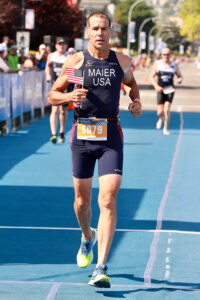
Kevin Maier
“Now I’m at the right end of my age group”
Kevin Maier, 65, was a different type of three-sport athlete growing up, football, basketball and baseball. The Liverpool native continued to play football at the University of Rochester under legendary coach Pat Stark. Maier then launched his career in the sports industry, selling gear and uniforms to youth, scholastic and professional teams, including the Buffalo Bills. After college, he remained active by playing softball and racquetball. He missed the intensity of the gridiron and gravitated to more physically challenging contests like 10K runs before entering his first triathlon in 1986.
“My shoelaces kept getting wrapped around the pedals and I got off the bike twice,” Maier recalled. “But, I fell in love with it.”
Thirty-five years later, Maier tallied more than 130 events. At 50, he did the Iron Man competition in Lake Placid, completing the 140-mile race in less than 12 hours. At 61, he finished eighth in his age group (60-64) at the world-level event in Canada. He retired from his full-time job in 2018. As Maier was interviewed just before his birthday this spring, he was excited about turning 65.
“Now I’m at the right end of my age group,” he said.
Still, the competition in the 65-69 age group will not be easy, especially this year. Many of his competitors from the southern states have been running and biking all winter, Maier said, “while I’ve been shoveling snow.”
During the pandemic, Maier and his wife spent their 2020 vacation money on an elliptical machine and a rowing machine. Maier regularly reserved one lane at a local pool where he and three of his peers practiced their freestyle strokes. In early June, they put on their wet suites and swam in Cazenovia Lake. During the colder months, they connected on their stationary bikes for zoom meetings.
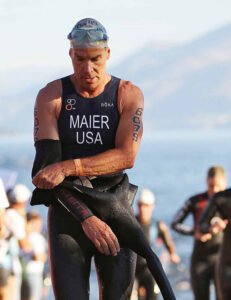
It’s not unusual for Maier to finish neck and neck with his friends and training partners in competitions, whether local or national. “Those that I train with I also compete with and we are often near each other in a race. We push each other and often finish near each other at the finish line”.
Maier estimates that, during the pandemic, he spent about 10 hours per week training during the winter months and up to 20 hours a week during the summer. That is specifically for triathlons and does not include other physical activities he enjoys that benefit his fitness, such as skiing.
He admitted that he doesn’t follow a very healthy diet during the holidays, especially between Thanksgiving and New Year’s, but his eating habits become much regimented after the holidays, with the main focus on consuming less sugar and more fruits and vegetables.
Maier’s advice to older adults who are thinking about attempting a triathlon: Go for it!
“I have not met anyone who said they regretted it,” he said. “Not even the few that just did one and were done. There’s a lot of support out there to get into this at your own pace. You can get by without a lot of work as long as you are maintaining a basic fitness level.”
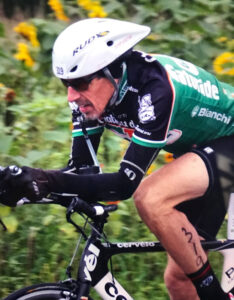
Larry Krieger
“You are racing against your own demons in your head”
Larry Krieger got his inspiration from two women: His sister, Lois, and Julie Moss, who became famous for crawling across the finish line in a televised triathlon in 1982. Nearly 40 years later, Krieger, now 63, prefers to complete in events where those who cross the finish line are considered not just finishers, but survivors.
The New Jersey native was in his first year of medical school when he and Lois, still motivated by Moss, signed up for a half Ironman event at the Jersey Shore. Lois changed her mind shortly before the competition and cheered her brother on from the sidelines instead.
“It was an eye-opening experience,” Krieger said. “I was happy just to finish.”
After that, both siblings participated in triathlon events, including Iron Man races. Throughout the mid-1980s they did 15-16 competitions per year.
Krieger, an ear surgeon, was able to train about 20-25 hours a week all through medical school and brought his passion for the sport with him to Syracuse.
Krieger’s favorite race when he began the sport is still his top choice today: The SOS triathlon in New Paltz. It’s an eight-stage wilderness race that, unlike traditional tri-events, does not start with the swim. The first stage is a 30-mile bike race that features a combination of flat roads, rolling hills and a climb into the mountains. Stage 2 is a 4.5-mile run. That’s followed by a 1.1-mile swim, which precedes a 5.5-mile run. Then there’s another half-mile swim, followed by an eight-mile run. Stage 7 is the last half-mile swim. The final 0.7-mile run is entirely uphill.
“You are racing against your own demons in your head,” Krieger said. “The toughest athlete gets reduced to tears.”
The race is limited to 150 participants, but, because of the danger level, requires more than 300 volunteers. Krieger has done this event 30 times, more than anyone else in the world. In 1990, his first-place finish was televised on ESPN. Lois also loved this race. She fought a long battle with cancer and completed her last SOS event past the age of 50 before she succumbed to the disease.
“It’s definitely a motivator for me to keep doing this race,” Krieger said.
Krieger cross-trains by doing tae kwon do, cross-country skiing and dog obedience training. “I compete with my dogs,” he said. In 2012, Krieger was sidelined from training and competitions for about six months after a flu vaccination gone wrong left him partially, but temporarily, paralyzed. He eventually returned to full strength.
Krieger’s drive and perseverance is uncanny. But, he does not recommend others to take the same approach: There is a difference between an enthusiast, and a fanatic.
“Train hard if you can, but take it in stride and enjoy it,” he said. “But be careful. Don’t let it take over your life.”
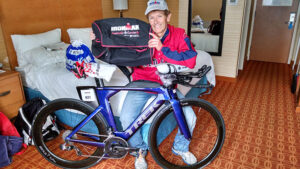
Rich O’Neil
‘Ease into it very carefully…and don’t go it alone.’
At 73, Rich O’Neil is the oldest of the bunch, but he’s not the most tenured. He became a triathlete in 2000, at the age of 53. He was a runner and first flirted with the idea of the multi-faceted competitions in the 1980s, after seeing a televised race on Wide World of Sports, but still could not imagine ever finishing something that grueling.
As they rang in the millennium during a New Year’s Eve party, friends pressured O’Neil to make that resolution and give triathlons a try. He pushed back, but the peer pressure placed on him was too strong.
“But I don’t have a wet suit,” he recalled saying at the time. “Then they said, we’ll loan you one. “I don’t have a road bike. Then someone else popped in — ‘I’ll loan you mine.’ I guess all of the stars came together.”
His first triathlon was in Elmira. He got two flat tires and didn’t finish. By then he already had two marathons under his belt and he refused to abandon the New Year’s resolution.
In his next attempt, he qualified for the world-level competition in Hawaii.
Two decades later, his resume includes 80 triathlons. Twenty-two of those were Ironman competitions (he finished 18 of the 22).
Over time, O’Neil prioritized triathlons over marathon foot races because the cross-training with biking and swimming alleviated some of the stress on his knees caused by so much running. He also got into weight lifting. He still participates in shorter foot races in the Syracuse area, typically 5 or 10ks, as way to supplement his speed training.
O’Neil, who still works full-time as an engineer with a department of transportation, continued his training routine as if none of the races were canceled. On a warm weekend afternoon, for example, he would ride 50 to 80 miles on his bike and run five miles. He makes his return to competition at the Eagle Man event, scheduled for June 13 in Cambridge, Maryland.
Before COVID-19, O’Neil completed an Ironman event in the 70-74 age group in 2019. There were only six others in that division. “It falls off rapidly,” he said. Next year, O’Neil will be the “young pup” in the 75-79 group.
The years bring more aches and pains, and the training gets increasingly difficult. O’Neil still trains with others who are a decade or more his junior. Sometimes he keeps up; sometimes the others have to circle back to him. O’Neil still loves the sport and cannot imagine walking away from it any time soon. He considers himself lucky to have avoided any major injuries. He keeps his weight down and, most importantly, if he has any pain, he gets appropriate rest.
“I don’t try to run through it,” he said.
O’Neil’s advice to other older adults who are thinking about giving the sport a try is two-fold: Ease into it very carefully. And don’t go it alone. Take advantage of the Central New York Triathlon Club.
“Make sure you can swim. Then, get into a spin class for an hour or two to see how you like it (bike training). Start with a shorter race and make sure you like it. But most of all you really need to join the triathlon club and see what’s involved. They will give you the encouragement. The longer distances you go, the more help you need.”
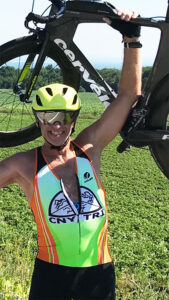
Mark Person
‘It’s not about trying to keep up with the 30-year olds. It’s about how well you can beat yourself.’
Mark Person’s advice to everyone, regardless of their situation, is: Be the best version of your aging self that you can be.
He remembers this daily. The 62-year-old Syracuse resident grew up on a dairy farm in Northern Illinois, where hard work was the norm. He was a four-sport athlete in high school who played football in college.
“When I first did track, I chose the shot put because I did not like running without a ball in my hands,” he recalled. But there is something in Person’s genes about time and distance. Both of his grandmothers lived to be 101. He dreams about someday being the 90-year-old guy at the podium who finishes an Ironman race.
At Manchester University, Person’s buddies on the cross-country team encouraged him to try running. He took their advice, ran 60 miles a week and dropped 30 pounds. He was invigorated by this experience and never looked back, finishing a 5k race in 15 minutes flat and running a mile in less than five minutes. He always enjoyed swimming and biking but never thought to try the combined events until he turned 56 years old. At first, triathlon training and competition did not come as easy to Person as foot races did. He suffered injuries during his first two years of training and could not enter the races he had prepared for.
He persevered in 2019, finishing the sprint triathlon race in Delta Lake, New York, qualifying for the national competition in his first attempt. The same year he finished fourth in his age group in the Cazenovia Triathlon.
Person, a vice principal at Christian Brothers Academy in DeWitt, is a fierce competitor who cannot stand to lose to anyone his age or older. When the pandemic hit, he found himself with more time to train. He does dry-land swimming by attaching tension chords to his arms and legs, tallying 1,500 strokes per session. He also has a stationary bike with an online screen that simulates rides through the Swiss Alps and other scenic, but difficult terrains throughout the world. And he runs outside year-round.
Last summer, Person did a practice half Ironman (70.3 miles) in hilly terrain between Jamesville and Pompey in less than six hours. His return to competition this year will start with the Green Lakes sprint triathlon in late June. A national-level event in Wisconsin is scheduled for August.
Person said he feels great, but he has had his fair share of wear and tear, including injuries to both knees. He has pins and wires in his right leg after 90 percent of his hamstring ripped. A post-surgery infection to one knee during the winter kept him out of the pool and off the bike for about a month. He’s persevered by using running shoes with thicker cushions that absorb some of the pounding on his feet and legs. And he follows a very strict keto diet aimed at maintaining 16 percent body fat.
“I haven’t put a quarter in a vending machine since I was 25 years old,” Person said.
His advice to those thinking about trying a triathlon or at least the training is the same thing he tells himself every day: Be the best version of your aging self.
“If you’re gonna live life to the fullest, why not move around and set goals? It’s not about trying to keep up with the 30-year-olds. It’s about how well you can beat yourself.”

